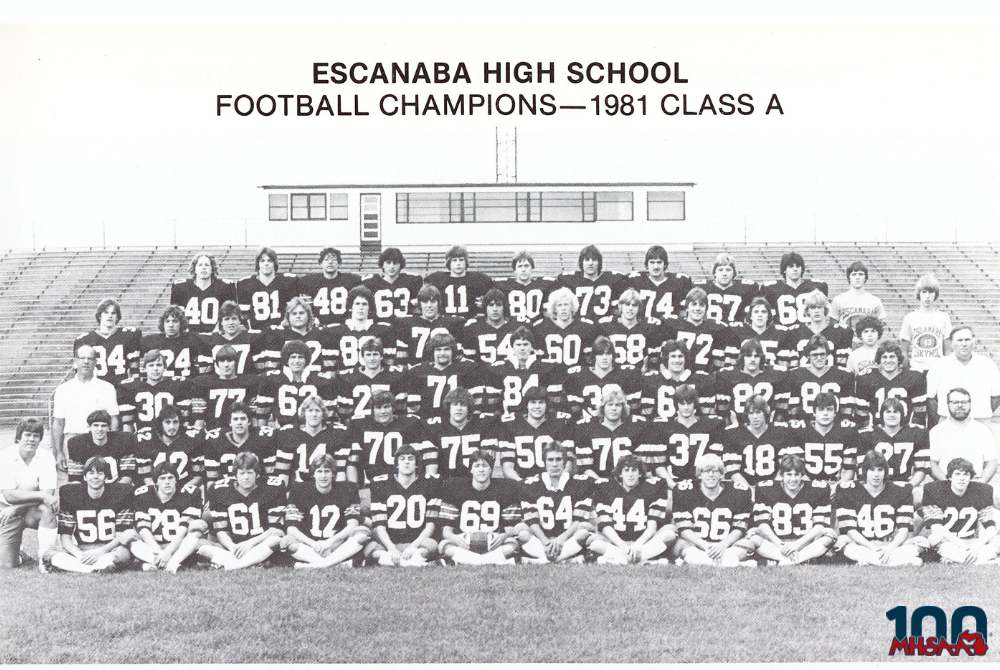
Add, Subtract, Divide, Multiply: MHSAA Not Alone
July 25, 2017
By Rob Kaminski
MHSAA benchmarks editor
This is the third part in a series on MHSAA tournament classification, past and present, that will be published over the next two weeks. This series originally ran in this spring's edition of MHSAA benchmarks.
As the MHSAA faces its most recent classification task with 8-Player Football, and opinions continue to swirl about as to the method, timeframe, location and other procedures, a look around the country provides plenty of company among state association brethren factoring variables into their own equations.
In the Pacific Northwest, the Oregon School Activities Association Football Playoffs are under public scrutiny as leadership ponders a five or six classification format beginning with the 2018-19 school year.
The OSAA has crowned six champions on the gridiron since 2006-07. Many of the state’s smaller schools would like to keep it that way, while larger schools lean toward a five-classification system, citing larger leagues, ease of travel and credibility to state championships as the advantages.
Still others would prefer more than six classes, pointing to safety issues and the opportunity to increase participation numbers as positives.
Moving southeast of Oregon, the Nevada Interscholastic Activities Association recently voted to hold serve on a classification proposal that was volleyed to the membership.
However, changes still could be forthcoming by as early as the 2018-19 season which would add a fifth classification in more populated southern Nevada while allowing northern schools to participate in four classifications. Such divisions could mean no state championship for the fifth class in southern Nevada.
Because of that, the NIAA wants equal numbers of schools in each classification on both ends of the state. Complicating the issue is the fact that the 24 largest schools in the state, by enrollment, are all in Clark County in Southern Nevada.
Across Nevada’s border into Arizona, charter schools are asking the Arizona Interscholastic Association to reconsider classification that was voted upon and approved in September 2015. That agreement called for the largest 33 percent of charter schools by enrollment to be placed in the state’s largest school classification, 3A, the middle 33 percent into 2A, and the smallest 33 percent into 1A.
Less than two years later the charter schools have had a change of heart and have asked to be considered the same as other Arizona public schools and be placed appropriately by enrollment beginning with the 2018-19 school year.
The situation in Arizona further illustrates how the public/private debate that all state associations have faced throughout existence now has the added dynamic of rapidly growing charter schools in today’s educational system, along with virtual school enrollment.
In the nation’s heartland, Nebraska has retooled its football classifications by using enrollment of boys students only in its schools rather than total enrollment. The Nebraska School Activities Association football-playing schools will kick off the 2018 season using this alignment.
Nebraska has three classes of 11-player football, with the smallest class divided in two, Class C-1 and C-2. The state also will have 8-player football for boys enrollments under 47, and the NSAA will sponsor a new 6-player tournament in 2018 for schools with 27 or fewer boys.
“This is a good proposal because some schools have a sizable imbalance between the number of boys and girls, and there’s a large gap (in enrollment) between the largest and smallest schools in Classes A and B,” NSAA executive director Jim Tenopir said. “I think this addresses both of those concerns.”
Swimmers in Georgia, meanwhile, will feel like they are moving with the current, rather than upstream in 2017-18, as the Georgia High School Association recently doubled the number of team championship events from two to four.
Swim enthusiasts can also count on longer days at the finals, as the top 30 finishers from the prelims will advance to the finals instead of 20, and all championship events will have three heats versus two.

Flashback 100: Future Baseball Pro Led Escanaba's Legendary Football Title Run
November 8, 2024
The MHSAA 11-player Football Playoffs have awarded 332 Finals champions over their first 49 seasons, and the total will grow by eight later this month.
However, only 22 of those titles have been claimed by teams from Michigan's Upper Peninsula. And of those, just one came in the state’s largest division.
That honor belongs to Escanaba, which won the Class A title in 1981, marking the first and only time a U.P. team has claimed the crown in either Division 1, Class A, or Class AA.
The 1981 Escanaba team, coached by the legendary Jerry Cvengros – who would later be inducted into the Michigan High School Football Coaches Association Hall of Fame – was led by Kevin Tapani. A dynamic two-way player, Tapani starred at both quarterback and safety. The Eskymos finished the season undefeated at 12-0, outscoring opponents by a combined 345-67. They shut out six opponents and defeated Fraser 16-6 in the title game at the Pontiac Silverdome.
While Tapani excelled in football, his true passion was baseball. He was a standout in high school and went on to become a four-year starting pitcher at Central Michigan University. In 1986, Tapani was selected by the Oakland A’s in the second round of the MLB Draft. He went on to enjoy a successful 13-year career in the majors, earning a 143-125 record, with a 16-9 season in 1991 when he helped lead the Minnesota Twins to a World Series title.
In recognition of his athletic achievements, Tapani was inducted into the Upper Peninsula Sports Hall of Fame in 2012 and named one of the Minnesota Twins' 50 all-time greatest players.
The 22 U.P. teams to win an MHSAA 11-player football championship:
1975 – Ishpeming – Class C
1975 – Crystal Falls Forest Park – Class D
1976 – Crystal Falls Forest Park – Class D
1979 – Ishpeming – Class C
1979 – Norway – Class D
1980 – Munising – Class C
1980 – Norway – Class D
1981 – Escanaba – Class A
1983 – St. Ignace – Class D
1992 – Lake Linden-Hubbell – Class DD
1993 – Kingsford – Class B
1993 – Iron Mountain – Class C
1997 – Lake Linden-Hubbell – Class D
1998 – Menominee – Class BB
2000 – Iron Mountain – Division 7
2002 – Negaunee – Division 6
2006 – Menominee – Division 5
2007 – Menominee – Division 5
2007 – Crysal Falls Forest Park – Division 8
2012 – Ishpeming – Division 7
2013 – Ishpeming – Division 7
2015 – Ishpeming – Division 7
Previous "Flashback 100" Features
Nov. 1: Flashback 100: Michigan High School Baseball Trio Provide World Series Voices - Read
Oct. 25: Flashback 100: Before Leading Free World, Ford Starred for Champion GR South - Read
Oct. 18: Mercy Links Legend Becomes World Golf Hall of Famer - Read
Oct. 11: Fisher Races to Finals Stardom on Way to U.S. Olympic First - Read
Oct. 4: Lalas Leaves High School Legacies on Ice & Pitch - Read
Sept. 27: Tamer's History-Making Run Starts in Dexter, Continues to Paris - Read
Sept. 20: Todd Martin’s Road to Greatness Starts at East Lansing - Read
Sept. 13: James Earl Jones, Dickson High Hoops to Hollywood Legend - Read
Sept. 6: Pioneers' Unstoppable Streak Stretches 9 Seasons - Read
Aug. 30: Detroit dePorres Rushes to 1995 Class CC Football Championship - Read
PHOTOS (Top) Escanaba's 1981 Class A championship team, Tapani is in the second row, fourth from the right (#18). (Middle) Kevin Tapani from his Escanaba Wall of Fame Plaque. (Photos courtesy of Escanaba High School, and the MHSAA archives.)

